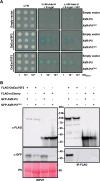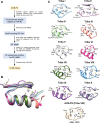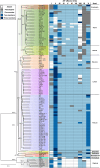Zinc-finger (ZiF) fold secreted effectors form a functionally diverse family across lineages of the blast fungus Magnaporthe oryzae
- PMID: 38885263
- PMCID: PMC11213319
- DOI: 10.1371/journal.ppat.1012277
Zinc-finger (ZiF) fold secreted effectors form a functionally diverse family across lineages of the blast fungus Magnaporthe oryzae
Abstract
Filamentous plant pathogens deliver effector proteins into host cells to suppress host defence responses and manipulate metabolic processes to support colonization. Understanding the evolution and molecular function of these effectors provides knowledge about pathogenesis and can suggest novel strategies to reduce damage caused by pathogens. However, effector proteins are highly variable, share weak sequence similarity and, although they can be grouped according to their structure, only a few structurally conserved effector families have been functionally characterized to date. Here, we demonstrate that Zinc-finger fold (ZiF) secreted proteins form a functionally diverse effector family in the blast fungus Magnaporthe oryzae. This family relies on the Zinc-finger motif for protein stability and is ubiquitously present in blast fungus lineages infecting 13 different host species, forming different effector tribes. Homologs of the canonical ZiF effector, AVR-Pii, from rice infecting isolates are present in multiple M. oryzae lineages. Wheat infecting strains of the fungus also possess an AVR-Pii like allele that binds host Exo70 proteins and activates the immune receptor Pii. Furthermore, ZiF tribes may vary in the proteins they bind to, indicating functional diversification and an intricate effector/host interactome. Altogether, we uncovered a new effector family with a common protein fold that has functionally diversified in lineages of M. oryzae. This work expands our understanding of the diversity of M. oryzae effectors, the molecular basis of plant pathogenesis and may ultimately facilitate the development of new sources for pathogen resistance.
Copyright: © 2024 Concepcion et al. This is an open access article distributed under the terms of the Creative Commons Attribution License, which permits unrestricted use, distribution, and reproduction in any medium, provided the original author and source are credited.
Conflict of interest statement
SK receives funding from Industry on NLR biology.
Figures





Similar articles
-
A blast fungus zinc-finger fold effector binds to a hydrophobic pocket in host Exo70 proteins to modulate immune recognition in rice.Proc Natl Acad Sci U S A. 2022 Oct 25;119(43):e2210559119. doi: 10.1073/pnas.2210559119. Epub 2022 Oct 17. Proc Natl Acad Sci U S A. 2022. PMID: 36252011 Free PMC article.
-
Effector-triggered susceptibility by the rice blast fungus Magnaporthe oryzae.New Phytol. 2024 Feb;241(3):1007-1020. doi: 10.1111/nph.19446. Epub 2023 Dec 10. New Phytol. 2024. PMID: 38073141 Review.
-
Magnaporthe oryzae Effector AVR-Pii Helps to Establish Compatibility by Inhibition of the Rice NADP-Malic Enzyme Resulting in Disruption of Oxidative Burst and Host Innate Immunity.Mol Cells. 2016 May 31;39(5):426-38. doi: 10.14348/molcells.2016.0094. Epub 2016 May 3. Mol Cells. 2016. PMID: 27126515 Free PMC article.
-
A nonclassically secreted effector of Magnaporthe oryzae targets host nuclei and plays important roles in fungal growth and plant infection.Mol Plant Pathol. 2023 Sep;24(9):1093-1106. doi: 10.1111/mpp.13356. Epub 2023 Jun 12. Mol Plant Pathol. 2023. PMID: 37306516 Free PMC article.
-
Investigating the cell biology of plant infection by the rice blast fungus Magnaporthe oryzae.Curr Opin Microbiol. 2016 Dec;34:147-153. doi: 10.1016/j.mib.2016.10.001. Epub 2016 Nov 3. Curr Opin Microbiol. 2016. PMID: 27816794 Review.
Cited by
-
Structure-guided insights into the biology of fungal effectors.New Phytol. 2025 May;246(4):1460-1477. doi: 10.1111/nph.70075. Epub 2025 Mar 25. New Phytol. 2025. PMID: 40130672 Free PMC article. Review.
-
Computational studies reveal structural characterization and novel families of Puccinia striiformis f. sp. tritici effectors.PLoS Comput Biol. 2025 Mar 28;21(3):e1012503. doi: 10.1371/journal.pcbi.1012503. eCollection 2025 Mar. PLoS Comput Biol. 2025. PMID: 40153705 Free PMC article.
References
MeSH terms
Substances
Supplementary concepts
LinkOut - more resources
Full Text Sources
Research Materials

